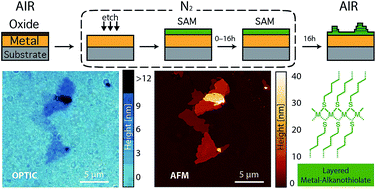当前位置:
X-MOL 学术
›
Chem. Sci.
›
论文详情
Our official English website, www.x-mol.net, welcomes your
feedback! (Note: you will need to create a separate account there.)
Spontaneous growth of 2D coordination polymers on functionalized ferromagnetic surfaces†
Chemical Science ( IF 7.6 ) Pub Date : 2018-09-18 00:00:00 , DOI: 10.1039/c8sc03067g Michele Mattera 1, 2, 3, 4 , Víctor Rubio-Giménez 1, 2, 3, 4 , Sophie Delprat 5, 6, 7, 8, 9 , Richard Mattana 5, 6, 7, 8, 9 , Pierre Seneor 5, 6, 7, 8, 9 , Sergio Tatay 1, 2, 3, 4 , Alicia Forment-Aliaga 1, 2, 3, 4 , Eugenio Coronado 1, 2, 3, 4
Chemical Science ( IF 7.6 ) Pub Date : 2018-09-18 00:00:00 , DOI: 10.1039/c8sc03067g Michele Mattera 1, 2, 3, 4 , Víctor Rubio-Giménez 1, 2, 3, 4 , Sophie Delprat 5, 6, 7, 8, 9 , Richard Mattana 5, 6, 7, 8, 9 , Pierre Seneor 5, 6, 7, 8, 9 , Sergio Tatay 1, 2, 3, 4 , Alicia Forment-Aliaga 1, 2, 3, 4 , Eugenio Coronado 1, 2, 3, 4
Affiliation

|
The spontaneous growth of lamellar metal-alkanethiolates (LMAs) on reactive ferromagnetic surfaces as a result of surface oxidation has been observed. When alkanethiol self-assembled monolayers (SAMs) grown under an inert atmosphere over cobalt or permalloy (Ni80Fe20) are exposed to air, oxygen diffuses through the molecular layer. This induces an oxidation of metal atoms at the metal surface and a release of the resulting metal cations that migrate coordinated by the alkanethiol molecules to form lamellar structures over the SAMs. This process has been imaged in real-time, under ambient conditions, by means of different microscopy techniques. The influence of the alkyl chain length, the nature of the ferromagnet, the temperature and the atmospheric moisture on the number, area and height of the resulting features has been systematically evaluated. Remarkably, the possibility to follow the migration in real-time makes it a promising model system for the study of surface/molecule interface processes. Most importantly, the composition and crystallinity of these LMAs have been studied, evidencing that real 2D coordination polymers are formed on the surface. Hence, one could envision this strategy as a new method for the assembly of more complex low-dimensional (2D) magnetic materials based on coordination polymers.
中文翻译:

二维配位聚合物在功能化铁磁表面上的自发生长†
观察到由于表面氧化,层状金属链烷硫醇盐(LMA)在反应性铁磁表面上的自发生长。当烷硫醇自组装单分子膜(SAMs)在惰性气氛下在钴或坡莫合金(Ni 80 Fe 20)暴露在空气中,氧气通过分子层扩散。这会诱导金属表面上的金属原子氧化,并释放所生成的金属阳离子,这些阳离子通过烷硫醇分子配位迁移,从而在SAM上形成层状结构。该过程已通过不同的显微镜技术在环境条件下实时成像。已经系统地评估了烷基链长,铁磁体的性质,温度和大气湿度对所得特征的数量,面积和高度的影响。值得注意的是,实时跟踪迁移的可能性使其成为研究表面/分子界面过程的有前途的模型系统。最重要的是,已经研究了这些LMA的组成和结晶度,证明在表面上形成了真正的2D配位聚合物。因此,可以将这一策略设想为一种基于配位聚合物组装更复杂的低维(2D)磁性材料的新方法。
更新日期:2018-09-18
中文翻译:

二维配位聚合物在功能化铁磁表面上的自发生长†
观察到由于表面氧化,层状金属链烷硫醇盐(LMA)在反应性铁磁表面上的自发生长。当烷硫醇自组装单分子膜(SAMs)在惰性气氛下在钴或坡莫合金(Ni 80 Fe 20)暴露在空气中,氧气通过分子层扩散。这会诱导金属表面上的金属原子氧化,并释放所生成的金属阳离子,这些阳离子通过烷硫醇分子配位迁移,从而在SAM上形成层状结构。该过程已通过不同的显微镜技术在环境条件下实时成像。已经系统地评估了烷基链长,铁磁体的性质,温度和大气湿度对所得特征的数量,面积和高度的影响。值得注意的是,实时跟踪迁移的可能性使其成为研究表面/分子界面过程的有前途的模型系统。最重要的是,已经研究了这些LMA的组成和结晶度,证明在表面上形成了真正的2D配位聚合物。因此,可以将这一策略设想为一种基于配位聚合物组装更复杂的低维(2D)磁性材料的新方法。











































 京公网安备 11010802027423号
京公网安备 11010802027423号